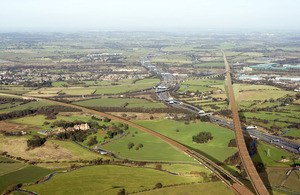HS2 moves a step closer with publication of draft 'Environmental statement' and design refinement consultations
Draft 'Environmental statement' and design refinement consultations launched.

The first phase of HS2, the planned high speed railway between London, the West Midlands, Manchester and Leeds moved another step forward today (16 May 2013) with the launch of consultations on the project’s draft Environmental statement (ES) and proposed design refinement.
The draft ES sets out HS2 Ltd’s current thinking on plans to integrate the line into the landscape using the very latest design and construction methods, both during building and operation.
The design refinement consultation is an opportunity to comment on the most significant proposed changes to the design of phase one of the scheme between London and Birmingham. The refinement, some of which has been made following representations from individuals and organisations, help make the railway the very best it can be.
Transport Secretary Patrick McLoughlin said:
HS2 is absolutely vital for this country, providing a huge economic boost which will generate a return on investment that will continue paying back for generations to come. But you cannot build a new railway line without causing some disruption.
What we can and will do is ensure that disruption is kept to a minimum by using the very latest design and construction methods.
We are confident that through continued hard work we can ensure that many of the feared effects of HS2 never materialise. We also know that the best design for the scheme can only be reached with the input of local communities, environmental groups and all levels of government.
Publication of these plans is a crucial next step and will ensure that construction of the first phase can begin within the next four years.
The draft ES and proposed design refinements are open to full public consultation with responses required by 11 July. Consultation on the draft ES is not a statutory requirement but the government recognises the importance of ensuring widespread engagement on the scheme. Its publication is an important stage in the project as it helps prepare the formal ‘Environmental statement’ that is essential for the Hybrid Bill – effectively the planning application for the project – due to be published later in 2013.
HS2 Ltd is seeking to build on the best practice of constructing and running a high speed network, established both on HS1 and abroad. It is looking to use technology unique to Europe in helping to cut the noise of high speed trains, such as eliminating the gaps between train carriages to cut noise as they travel and boost their aerodynamic efficiency.
Drawing on Japanese expertise, HS2 trains could also be fitted with wheel farings, like on a Citroen DS car, to cut the noise made by the wheels on rails – the biggest source of noise on any electrified railway.
Around 70% of the line’s surface sections between London and the West Midlands will be insulated by cuttings, landscaping and fencing, helping it to harmonise with the landscape.
Earth removed for track laying could be used beside it as noise-absorbing bunds, cutting the amount of earth that has to be transported and therefore reducing the number of tipper truck journeys which create congestion, disruption and pollution.
The most significant proposed design refinement being consulted on for phase one includes tunnelling under Ealing and Northolt in north west London, and at Bromford in the West Midlands. Also published for consultation are revised proposals to redevelop and improve Euston Station to accommodate high speed trains for HS2 without having to knock down and rebuild the entire station.
Notes to editors
High Speed 2 (HS2) will be a new 351 mile high speed railway linking the Britain’s key population centres.
It will link 8 of Britain’s 10 biggest cities, bringing our major cities closer together and two-thirds of people in the North to within 2 hours of London.
The government believes that HS2 will be a vital engine for growth that will help rebalance the economy.
The government published its preferred route for the first phase of HS2 in 2011, consulted the public on the plans and then confirmed the route in January 2012.
Today’s (16 May 2013) draft ES takes account of some recent proposed changes to the route, designed to improve the design of the railway and mitigate environmental impacts. These design changes are themselves also subject to a separate parallel consultation which has also begun today (16 May 2013).
To get powers to build HS2 the government will need to take a Hybrid Bill through Parliament. The full Bill for the first phase of HS2 will be put before Parliament by the end of 2013, the government is aiming for Royal Assent by 2015 with construction on HS2 beginning in 2016 to 2017.
The draft ES sets out a factual assessment of the environmental effects and proposed mitigation for phase one of the railway. The consultation will run for 8 weeks from 16 May 2013 to 11 July 2013.
The design refinement consultation sets out proposed major changes to the design of the phase one route. The consultation will run for 8 weeks from 16 May 2013 to 11 July 2013.
A written ministerial statement has been published in Parliament today (16 May 2013).
HS2 will generate jobs and rebalance the country’s economy, acting as a catalyst for Britain’s future prosperity and creating 100,000 jobs.
HS2 and major projects media enquiries
Media enquiries 0300 7777 878
Switchboard 0300 330 3000